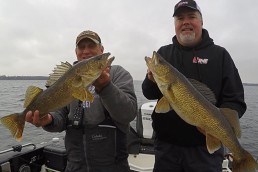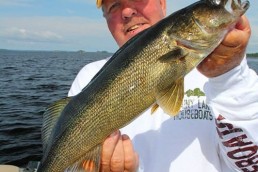‘Rap’ Music 101: Mastering an Offbeat Walleye Presentation
SHARE THIS POST
It never fails to amaze me how many baits flood the market each year, but how few become enduring fish catchers. Fact is, what creates a fish-catching phenomenon is not just the bait but the interpretation of how, when and where the bait should be fished. Great fish-catching systems start with an effective lure, but the oxygen that fuels them is a set of instructions communicated by virtuoso tournament anglers and guides who apply the lure to a variety of situations, with almost magical results.
Case in point: the Jigging Rap, which has been around for decades as a go-to ice fishing bait—and would have stayed in hardwater circles had it not been for a few innovative walleye anglers. In the early 2000s, Professional Walleye Trail (PWT) angler Kim Papineau began using the bait in open water. Then Al Lindner picked up on what Papineau was doing, and set out to refine the technique. In time, more guides and tournament anglers brought the bait in their boats. Most recently, both the 2013 and 2015 National Walleye Tour (NWT) championships were won on Jigging Raps. The word is out, but many anglers are still in the dark about how to use this bait in open water.
Not just for walleyes
Jigging Raps catch more than walleyes. Smaller #3 and #5 models are aces for panfish, especially during late summer, fall and winter. They’ve taken the bass world by storm, too. Even saltwater anglers are beginning to harness the power of the erratic-moving bait. But for this story, we’ll focus on our marble-eyed friends.
Jig, cast or troll?
As with most artificial baits, there are myriad ways to fish a Jigging Rap. As a reaction bait, you might need to adjust your stroke and tempo to trigger fish, experimenting until you match their mood at the moment. Some days, walleyes might prefer erratic and elusive movements; other days, a more subtle cadence can be the ticket.
Let the walleyes tell you what they want, but here are my rules of thumb.
One of the first questions I get asked is, “should I troll or cast Jigging Raps?”
My answer is both, in a variety of ways. Slow trolling with an electric motor, casting, vertical jigging, drifting and maneuvering in current, they’re all effective approaches.
Slow trolling with an electric motor
One of the best ways to fish a Jigging Rap is to locate fish with your electronics and systemically work the area with a bow-mount or transom-mount trolling motor. Sometimes I’ll set the Spot-Lock electronic anchoring function on my Minn Kota Ulterra (my bow-mount electric) and vertically “bomb drop” to the fish I see on the screen. Other times, I might back-troll into the wind with the Vantage transom-mount electric motor. However you do it, the key is to keep the Jigging Rap in direct relation to the bottom and fish location, so keep your speed slower than 1 mph. You can, though, speed up a bit to cover more water if fish appear to be roaming larger areas. Stay flexible.
How to work the bait: the key is to be deliberate and consistent. I use a three-foot rod motion, starting at 9 o’clock, moving up to 11 o’clock, then returning for a short rest at 9 o’clock. This creates a ‘bird-in-flight’ bait motion while bringing the bait back to the same depth at the end of each stroke. I keep my rod tip close to the water surface, because I like how I can feel bites and set the hook from that position. Many times, you’ll simply feel the weight of a fish as you move forward to repeat the stroke, so there’s no need for a power hookset. Given the needle-sharpness of the Jigging Rap’s hooks, a firm pull is all you need.
Casting
Besides fishing vertically or on a slow troll, casting can be effective. Al Lindner has had great success casting and retrieving Jigging Raps around structure, breaks and shallower flats, as his partner trolls a Jigging Rap behind the boat. Al is in the bow, running an electric motor, which moves the boat enough for his partner to troll. As the boat moves along slowly, Al pitches the bait out and retrieves it back, alternating between a fairly smooth swimming presentation, and a more erratic series of twitches and pauses.
Are you enjoying this post?
You can be among the first to get the latest info on where to go, what to use and how to use it!
Here’s how I set the stage for using Al’s method: because we have side imaging technology on the new Humminbird sonar units, I use it all the time, slowly idling along, checking structures and edges and the water just off the structures. I’m looking for pods of fish, and I can spot them without driving the boat over the top of them, which we have to do with traditional sonar. That’s a huge advantage.
As an example, I might locate pods of walleyes scattered on a structure. Rather than troll over the walleyes, I back off the boat, to avoid spooking them, and hold in prime casting position. Technology to the rescue again, because Minn Kota has developed a feature call Spot-Lock, that automatically runs the motor to keep you in the same place, as the wind tries to move you. Now, I can precisely fish the places I saw the walleyes.
Here’s how to present the Jigging Rap: After making a long cast, follow the bait down with your rod tip and leave the bail open until the bait hits bottom. Close the bail and start your retrieve. (You can also cast, close your bail and follow the bait down, which allows you to react immediately to a strike as the bait sinks.) Reeling down to the 9 o’clock position, then pulling up to 11 o’clock, is the best way to get the feel of this cast-and-retrieve presentation. Again, acquiring a cadence takes time, but this is a great way to fish quickly and thoroughly. Tip: when following the bait back down, be ready for a walleye to be there when you come back up. You can also do a ‘kind of sideways’ retrieve, but casting directly forward and working back seems to be the most effective.
Current is a factor
Jigging Raps can also be effective in current areas. Whether you’re anchored up, drifting, or casting, current presents entirely different scenarios. Water motion and speed can impart actions that can’t be created via retrieves in still waters. One of the most effective methods is to orient the boat upstream of a river hole and anchor in position (I use a Talon, or the SpotLock feature if current isn’t too strong). Cast the Jigging Rap into the deeper water of the hole. Let it tumble down into the hole, then make successive two- to three-foot rod pulls, gradually bringing the bait up and over the lip of the hole and back to the boat. Experiment with lure size to keep the bait in contact with bottom. I often size up to a #9 in current situations.
Size matters
In addition to current strength, Jigging Rap size is dictated by water temperature, depth, speed, structure type, location, and forage size. For walleyes, I might use a #5 early in the season or in shallow water, but typically fish a #7, sizing up to a #9 in late summer and fall. I also reach for the #9 in deeper water.
As for color, I start with patterns that mimic the forage where I’m fishing. Water clarity can also be a deciding factor. Perch patterns are typically my first choice, but several other colors work equally as well. I can’t emphasize enough that trial and error is key to fishing these baits. Play with size, color and cadence to find out what the walleyes want. Don’t give up too early if you’re not getting bit; change size, color and cadence.
Always learning
The learning curve with new presentations never fails to amaze me, and after years on the water, I’m still learning. While I’m constantly reminded that there are no absolutes in fishing, learning to fish the Jigging Rap has given me a new way to catch walleyes on about any body of water, any time of year.
Book a day on the water with Tom Neustrom at mnfishingconnections.com.
MWO
SHARE THIS POST
Did you enjoy this post?
You can be among the first to get the latest info on where to go, what to use and how to use it!




